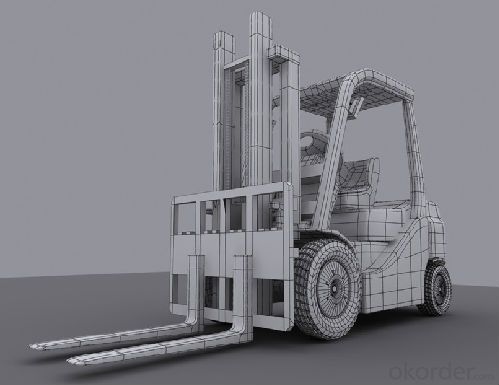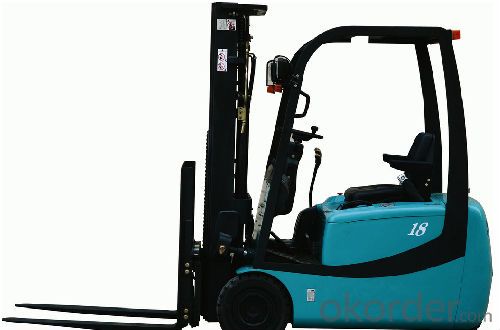Loading Port:Shanghai
Payment Terms:TT or LC
Min Order Qty:1 unit
Supply Capability:1 unit/month
Forklift Description:
Design types
A truck mounted forklift.
The following is a list, in no particular order, of the more common lift truck types:
Hand pallet truck - no on-board power system of any kind; the operator's muscle power is used to jack-up and move loads.
Walkie low lift truck- powered pallet truck, usually electrically powered
Rider low lift truck - usually electrically powered
Towing tractor - may be internal combustion engine or electrically powered
Walkie stacker - usually electrically powered
Rider stacker - usually electrically powered, e.g., A Ergo
Reach truck - variant on a Rider Stacker forklift, designed for small aisles, usually Electrically Powered, named because the forks can extend to reach the load. There are two variants, moving carriage, which are common in North America, and moving mast which are common in the rest of the world, and generally regarded as safer
Electric Counterbalanced truck- comes in Stand on End Control, Stand on Center Control, and Sit Down Center Control, which is the most numerous
Internal Combustion Engine Powered Counterbalanced Forklift- comes in Stand on End Control, Stand on Center Control, and Sit Down Center Control, which is the most numerous. Engines may be diesel, kerosene, gasoline, natural gas, butane, or propane fueled, and may be either two stroke spark ignition, four stroke spark ignition (common), two stoke compression ignition, and four stroke compression ignition (common). North American Engines come with advanced emission control systems. Forklifts built in countries such as Iran or Russia will typically have no emission control systems.
Electric forklifts - powered by lead-acid batteries, several types of forklifts are electric: cushion tire forklifts, scissor lifts, order pickers, stackers, reach trucks and pallet jacks. Electric forklifts are primarily used indoors on flat, even surfaces. Electric forklift batteries last 6 consecutive hours or throughout an 8-hour shift with 2-3 breaks. Batteries prevent the emission of harmful fumes and are recommended for facilities in food-processing and healthcare sectors.
Fuel cell forklifts produce no local emissions, can work for a full 8-hour shift on a single tank of hydrogen, can be refueled in 3 minutes and have a lifetime of 8–10 years. Fuel-cell-powered forklifts are often used in refrigerated warehouses as their performance is not degraded by lower temperatures.
Sideloader - comes in Stand on End Control, and Sit Down End Control, which is the most numerous. It may be electrically powered, or have an internal combustion engine. Engines may be diesel, kerosene, gasoline, natural gas, butane, or propane fueled, and may be either two stroke spark ignition, four stroke spark ignition (common), two stoke compression ignition, and four stroke compression ignition (common). North American Engines come with advanced emission control systems. Forklifts built in countries such as Iran or Russia will typically have no emission control systems. Some sideloaders have hybrid drivetrains.
Telescopic handler - comes in Stand on Center Control, and Sit Down Center Control, which is the most numerous. Usually has an Internal Combustion Engine. Engines are almost always diesel, but sometimes operate on kerosene, and sometimes use propane injection as a power boost. Some old units are two stoke compression ignition, most are four stroke compression ignition (common). North American Engines come with advanced emission control systems. Forklifts built in countries like Iran or Russia will typically have no emission control systems. Some Telescopic handlers have Hybrid drivetrains.
Walkie Order Picking truck - usually Electrically Powered
Rider Order Picking truck - commonly called an "Order Picker"; like a small Reach Truck, except the operator rides in a cage welded to the fork carriage, while wearing a specially designed safety harness to prevent falls. A special toothed grab holds the pallet to the forks. The operator hand transfers the load onto the pallet one article at a time. This is an efficient way of picking less than pallet load shipments, and is popular for use in large distribution centers.
Forklift Specification:
Model | CPCD40FR | |
Load capacity kg | 4000kg | |
Load center mm | 500mm | |
Power type | Diesel | |
Max.lifting speeds(with load)mm/s | 300mm/s | |
Max.Driving speeds(with without load) km/h | 18/20km/h | |
Max.Towing speeds | 16.5/11.5kN | |
(with/without load)kN |
| |
Gradeability(with/without load)% | 15/20% | |
H1 Lifting height mm | 3000mm | |
Free lift mm | 80mm | |
Tilting angles(forward-backward) 。 | 6/12 | |
Min. turning radius mm | 2720mm | |
Min. right angle aisle width mm | 2320mm | |
Min. under-clearance mm | 135mm | |
Dimensions | A Overall length(inincluding fork) mm | 4100mm |
B Overall width mm | 1230mm | |
H Overall height(mast lowered) mm | 2100mm | |
H2 Overall height (mast extend) mm | 4270mm | |
H3 Overall height to overhead guard mm | 2110mm | |
A1 Fork overhang mm | 470mm | |
A2 Wheel base mm | 1900mm | |
Tread | B1 Front tread mm | 1060mm |
B2 Rear tread mm | 970mm | |
Tyre | Front tyre | 250-15 |
Rear tyre | 6.50-10 | |
Total weight kg | 4900kg | |
B3 Fork width mm | 150mm | |
H4 Fork thickness mm | 50mm | |
Backrest height mm | 1225 | |
A3 Fork length mm | 1220mm | |
Engine | Engine model | 498 |
Rate power KW | 45KW | |
Rotate Speed At Rate Power rpm | 2500 | |
Max.torque Nm | ≥93 | |
Rotate speed at max torque rpm | 1800-1900rpm | |
Type of power shift | Hydraulic | |
Forklift images:



FAQ of forklift:
Q: What’s the function of forklift?
A: A forklift truck (also called a lift truck, a fork truck, or a forklift) is a powered industrial truck used to lift and move materials short distances. The forklift was developed in the early 20th century by various companies including the transmission manufacturing company Clark and the hoist company Yale & Towne Manufacturing. Following World War II the use and development of the forklift truck has greatly expanded worldwide. Forklifts have become an indispensable piece of equipment in manufacturing and warehousing operations.
Q: What’s the general operations of forklift:
A: Forklift cab with control layout.
Forklifts are rated for loads at a specified maximum weight and a specified forward center of gravity. This information is located on a nameplate provided by the manufacturer, and loads must not exceed these specifications. In many jurisdictions it is illegal to remove or tamper with the nameplate without the permission of the forklift manufacturer.
Q: What are the Forklift safety Standards?
A: 1, Forklift safety is subject to a variety of standards world wide. The most important standard is the ANSI B56—of which stewardship has now been passed from the American National Standards Institute (ANSI) to the Industrial Truck Standards Development Foundation after multi-year negotiations. ITSDF is a non-profit organization whose only purpose is the promulgation and modernization of the B56 standard.
2, Other forklift safety standards have been implemented in the United States by the Occupational Safety and Health Administration (OSHA) and in the United Kingdom by the Health and Safety Executive.
3, Driver safety: In many countries forklift truck operators must be trained and certified to operate forklift trucks. Certification may be required for each individual class of lift that an operator would use.